
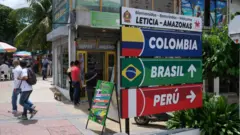
Image source, Getty Images
-
- Author, José Carlos Cueto
- Author's title, BBC News world correspondent in Colombia
- X,
“The Government of Peru has copied a territory that is from Colombia.”
The phrase was written on Tuesday, Colombian president Gustavo Petro in X and immediately surprised Peru.
“We have read these writings that are attributed to Gustavo Petro.
With “these matters”, Schialer refers to sovereignty over the island of Santa Rosa.
This is a small formation in the middle of the Amazon River, emerged in the second half of the twentieth century and inhabited by around 3,000 people, which Lima considers his in a claim that Colombia disputes.
Like Santa Rosa, several islands have emerged in recent years at the Colombo-Peruana border, defined for a century by the deepest channel of the Amazon.
Internationalist experts consulted by BBC Mundo agree that they are “nobody islands” at least until both countries do not binationally reevaluate their domains, since when Colombia and Peru defined their limits, these formations did not exist.
Last June, the Peruvian Congress approved “the creation of the new district of Santa Rosa de Loreto” on Santa Rosa Island.
This Tuesday, in addition to expressing his rejection in front of this, President Petro announced that he would move the commemoration of the Boyacá Battle, a key to Colombia's independence in the nineteenth century, to Leticia, the Colombian Amazon capital located a few meters from the island in dispute.
Live border
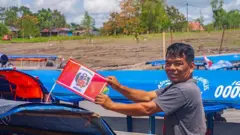
Image source, AFP via Getty Images / Santiago Ruiz
In 1922, Colombia and Peru signed a border treaty in which they defined their limits in the Amazon.
“The river layout was divided between the two states not by half, but for the best navigable groove, the deepest,” explains to BBC World Walter Arévalo, professor of international law at the University of the Rosario in Colombia.
That treaty, according to the Colombian historian Felipe Arias Escobar, created rejection on both sides, giving rise to the 1932 Colomboan War that ended the ratification of the agreement signed in 1922.
“It is a conflict at the service of nationalism that at the time served to strengthen national identity,” says Arias Escobar, of the Javeriana University, BBC Mundo.
Peru and Colombia share 116 kilometers from Río Amazonas.
“When the treaty was signed, in front of Leticia, there were only two islands, that of Ronda and another that has grown and expanded, Chinería,” complements BBC Mundo Santiago Duque, professor of Limnology from the National University of Colombia.
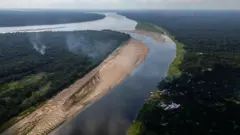
Image source, AFP via Getty Images / Luis Acosta
That is, the border between Colombia and Peru is a living, changing border, that both countries must review every so often.
The problem is that they have not done years.
Meanwhile, the border changed, with lumps of sediment from the Andes and dragged by the river that became new territories that is yet to be defined to which country they belong to.
Arévalo defends that the most logical position is that a binational commission is reactivated for the inspection of the border and that “neither Peru nor anyone will draw a law that unilaterally says that an island is yours.”
“It is the time for countries to feel the new geographical situation and make decisions. There are more than seven new islands, including Santa Rosa,” Duke adds.

What do Peru and Colombia say
Peru defends that the district of Santa Rosa is under its sovereignty and legal.
“The town of Santa Rosa is an integral part of the Peruvian island of Chinería, assigned to Peru in 1929,” said the Peruvian government in a statement issued on Tuesday.
In the same line the Chancellor of Peru pronounced, who defends that although the deepest groove of the Amazon River is moved “does not mean that the border moves.”
“One of the islands that was assigned to Peru was Chinero and, in the 50s, the river spits a part that was later called Santa Rosa Island. It was not born or emerged, but was part of Chinería,” says Schialer a BBC Mundo.
“What happens is that this river furrow later dried and reintegrated Chinería. Not only Santa Rosa was Peruvian, but is still Peruvian,” adds the chancellor.
Since 1970, says the diplomat, a school, a migration office and another of customs administration were built without “never saying anything about Colombians.”
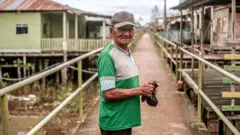
Image source, AFP via Getty Images
“We should not ask a friendly nation what we can do or not in our territory,” Schialer summarizes.
The Foreign Ministry of Colombia, however, announced on Tuesday that it has presented strong protest notes to the Peruvian government to request the reactivation of the Permanent Mixed Commission for the Inspection of the Colombo-Peruana Frontera (Comperif).
According to this ministry, “in order that, based on an allocation methodology, it is decided on the sovereignty of the islands arising in the course of the Amazon River after 1929”.
“For years, Colombia has maintained the need for the binational work for the allocation of islands and has reiterated the position that the 'Island of Santa Rosa' has not been assigned to Peru,” says the statement.
Petro, on the other hand, says that Peru is committing a “unilateral and violation” action that can “make Leticia disappear as a Amazon port removing her commercial life.”
The Colombian president argued that “islands have appeared north of the current deeper line, and the Government of Peru has just appropriated them by law and put the capital of a municipality in a land that, by the treaty, must belong to Colombia.”
“The Government will use, first of all, the diplomatic steps to defend national sovereignty,” he added.
Leticia's problem
Leticia is facing a capital challenge.
Because of sedimentation, deforestation and climate change, the Amazon in front of the city is losing flow and diverting towards Peruvian territory.
A study of the Faculty of Mines of the National University recently warned of the risk that Colombia can lose its most important river connection.
“A model developed by the National Navy has anticipated for several years that, by 2030, the Amazon River could stop in front of Leticia during most of the year (…) Today the model is a reality,” says the study.
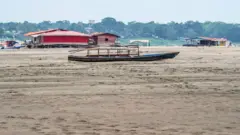
Image source, AFP via Getty Images / Santiago Ruiz
“If you do not act immediately, Leticia will no longer be a riverside city. The implications go beyond the symbolic; they are cultural, economic and territorial,” Professor Lilian Posada García, involved with research, pronounced in this regard.
Petro fears that the actions of Peru in Santa Rosa and Chinería, somehow, “make Leticia disappear as Amazon port removing her commercial life,” he said in X.
When asked about this concern, Peru's chancellor assured BBC Mundo that they would use the diplomatic and collaboration routes between countries to “effectively help the people.”
The alerts of experts
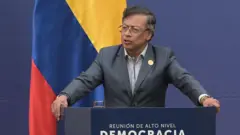
Image source, AFP Vitty Images / Rodrigo Arangua
Often, various analysts call “distraction maneuvers” or “attempts to impose the agenda” several of Petro's statements or plays, without necessarily indicating an objective beyond the media effect.
However, Sandra Borda, an expert in international relations at the University of Los Andes in Colombia, tells BBC Mundo that “since last year there were people in the Foreign Ministry alerting Petro about this situation.”
“I do not know why he decides to get the issue now, because it is a serious matter. Colombia runs the risk that Leticia is without access to the river, which, strategically, is fatal to the country,” says the specialist.
In July 2024, the then director of Territorial Sovereignty of the Ministry of Foreign Affairs of Colombia, Diego Cadena, said that Santa Rosa Island, located on the Amazon border, “would not belong to Peru” and “would be irregularly occupied”, after which the authority of the mayor of Santa Rosa, the Peruvian Iván Yovera.
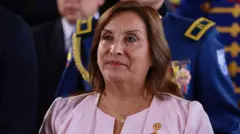
Image source, Getty Images
For that reason, the Government of Peru protested before Colombia's head of business in Lima and reaffirmed “the rights of sovereignty and jurisdiction over Santa Rosa Island.”
The then Peruvian Foreign Minister Javier González-Olaechea, closed the discussion on July 15, 2024 by expressing his “satisfaction” for the response of the Colombian government to the protest that his country issued.
Gustavo Petro and his Peruvian counterpart, Dina Boluarte, have suffered important comings and goings.
After the dismissal of Pedro Castillo of the Peruvian government and the arrival of Boluarte in 2022 as a constitutional president until the end of the mandate in 2026, Petro criticized the legitimacy of the new president, which originated a diplomatic conflict that led to the mutual withdrawal of its ambassadors in both countries.
Since then relationships have improved, but this last controversy threatens to reinflage them.

Subscribe here To our new newsletter to receive every Friday a selection of our best content of the week.
And remember that you can receive notifications in our app. Download the latest version and act.